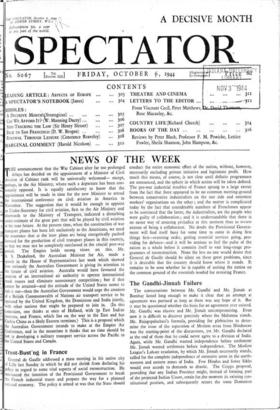The Gandhi-Jinnah Failure
The conversations between Mr. Gandhi and Mr. Jinnah at Bombay lasted long enough to make it clear that an attempt at agreement was pursued as long as there was any hope of it. But it may be questioned whether the basis for an agreement ever existed. Mr. Gandhi was elusive and Mr. Jinnah uncompromising. Even now it is difficult to discover precisely where the Mahatma stands. Mr. Rajagopalachari's formula, providing for plebiscites to deter- mine the issue of the separation of Moslem areas from Hindustan was the starting-point of the discussions, yet Mr. Gandhi declared at the end of them that he could never agree to a division of India. Again, while Mr. Gandhi wanted independence before settlement Mr. Jinnah wanted settlement before independence. The Moslem League's Lahore resolution, by which Mr. Jinnah necessarily stands, called for the complete independence of extensive areas in the north- western and eastern zones of India. Few Hindus and fewer Sikhs would ever accede to demands so drastic. The Cripps proposal, providing that any Indian Province might, instead of forming part of the projected Indian Union, retain for.the moment its existing con- stitutional position, and subsequently secure the same Dominion
status (in which is inherent the right of secession) as the Indian Union probably comes nearer to providing a basis for agreement than any other so far put forward. Accord between Mr. Gandhi, even though he represented only himself, and Mr. Jinnah might have opened the way to the necessary next step—the framing of a new constitu- tion for India by Indians themselves. The full application of the 1935 Act, with some revision, would probably be the best practical solution of all ; it is unfortunately not likely to commend itself to Indian opinion. The alternative is some new attempt to reconcile communal differences. .



























